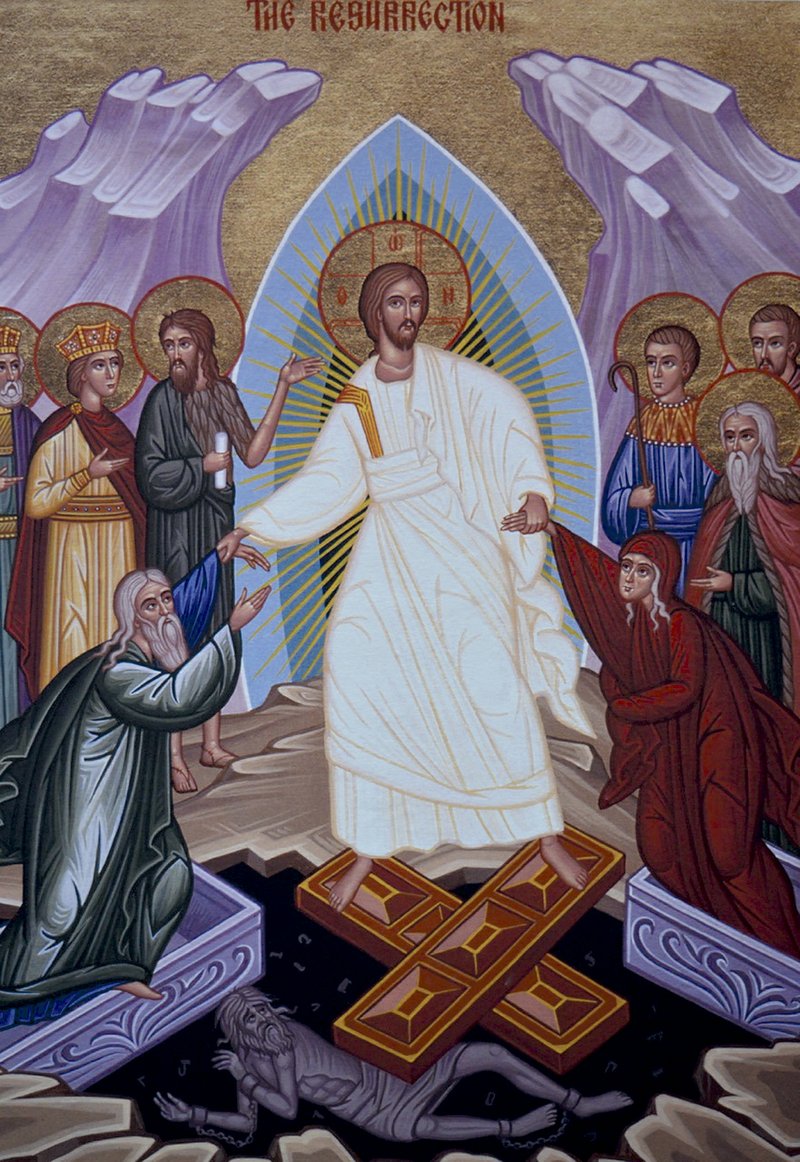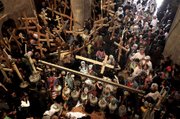It has been almost five weeks since Christians around the world celebrated Easter, but for Orthodox Christians the celebration comes at midnight tonight.
The difference in dates happens because Orthodox Christians base the date of Easter, or Pascha, as they call it, on the old Julian calendar. Differences between the two calendars mean that some years Easter falls on the same Sunday for Christians in the East and West, while other years, like this year, the dates can be as much as five weeks apart. No matter the date, Easter in East and West commemorates the same event -- the resurrection of Jesus.
"Easter is by far the seminal moment, not only of our life, but our faith," said the Rev. Nicholas Verdaris, priest at Annunciation Greek Orthodox Church in Little Rock. "Without Easter, there is nothing. Easter is what defines us as Christians. All our hope rests in the confidence in the Lord's resurrection."
Verdaris said Easter is the linchpin of the faith.
"Without Easter there is no Christianity," he said.
The Rev. John Atchison, priest at St. Nicholas Orthodox Church in Springdale, calls it "the holiday of holidays."
"By far it's the most important," he said.
The journey to Easter in the Orthodox tradition began with the start of Great Lent on March 14, but the fasting in preparation began one week prior, on Meatfare Sunday, after which no meat can be eaten until Easter Sunday. Cheesefare Sunday, which fell on March 13, added another layer to the fast by marking the end of eating eggs or dairy products until Easter. The goal is to fast in secret and not be boastful about depriving oneself.
The anticipation of the Resurrection increases during Holy Week, a particularly busy time in Orthodox churches.
"Holy Week really takes us on an immersive experience," Verdaris said. "We have services every single night that help us follow in the footsteps of the last days of the Lord leading up to his crucifixion, burial and resurrection."
The journey begins with Lazarus Saturday, a day to remember Christ raising his friend from death. The Rev. Joseph Bittle, priest at Holy Trinity Orthodox Church in Little Rock, said the day also foreshadows the power Christ will have over death after his crucifixion.
Palm Sunday follows, recalling Christ's entrance into Jerusalem. Worshippers traditionally wave palm fronds and some wave crosses made of the fronds. Services on Sunday, Monday and Tuesday evenings are a time to observe the Service of the Bridegroom and the days are filled with a sense of anticipation of the coming passion of Christ. On Wednesday a healing service, known as a service of unction, is held and worshippers are anointed with oil and receive prayers of healing.
Holy Thursday begins with the commemoration of the Last Supper and, unlike in the West, that evening worshippers remember the crucifixion of Christ. The service features 12 readings from the Gospels and parishioners re-enact the crucifixion by nailing or placing an icon of Jesus on a cross.
"We have an icon of the crucifixion at the front and it allows people to feel spiritually like they are joining the women and John at the foot of the cross keeping watch," Verdaris said. "It can be a long service, but it's a very powerful service. The tone is not celebratory but very somber. We are in awe of God's sacrifice as we hear of the events -- the mocking, the scourging and ultimately his death on the cross."
On the morning of Holy Friday, the service features the reading of prophetic Scriptures, psalms and the Gospels. That afternoon the icon of Christ will be taken down from the cross, wrapped in a shroud and placed on a funeral bier decorated with flowers. That night the somber service of Lamentations is held.
"The main theme is being with those who had gone to the tomb to lament his death," Bittle said. "The hymnography reflects upon that and on the sorrow of his mother."
The bier is then carried in a procession around the outside of the church. After that, it is held aloft and parishioners stoop to walk underneath it to re-enter the church.
"They have to bow down a little bit to re-enter the church and that hearkens to the experience of Christians who would be at the Church of the Holy Sepulcher in Jerusalem celebrating the same services," Bittle said. "It's an extension through space, and these objects and rites of actually doing something in Jerusalem, because in order to enter there you have to bow down. [The shrine of the tomb] has a little door. It's a physical mimicking and also an act of humility."
On Holy Saturday Orthodox Christians commemorate Christ's descent into Hades, also known as the "harrowing of hell," when they believe he preached to those trapped there and liberated them.
"He was giving them the opportunity to believe," Atchison said. "We believe he took all of them out of hell. We take it literally. We don't try to explain it. It's in that area of mystery."
The icon of the Resurrection depicts the scene. Christ is pictured in the center, usually clothed in white with a dazzling light in the background. On one side are the Old Testament prophets, who were looking for the coming of the Messiah. On the other side are figures of shepherds and others who represent humanity and stand in awe of what they see, Verdaris said.
"The most striking of all is, Christ in the center is depicted pulling up a male figure and on the other side, a female. They symbolize Adam and Eve and he is raising all the dead unto life," Verdaris said. "Beneath his feet are broken keys and locks and the gates of hell have been shattered."
The message is that Christ "has freed us of the tyranny of death," Verdaris said.
One small but significant detail of the icon is often overlooked -- Christ is gripping Adam and Eve by the wrist as he pulls them out of hell.
"They are not partners in this event," Verdaris said. "It's very deep in meaning and beauty. We ourselves have no power to make this unfold. It is God alone. He is pulling them up, raising them by his own power and authority. They are not holding his hand. Only God alone by his own power, will and authority can grant us life."
The services that morning highlight Christ's victory over death.
"There's a beautiful rite just before the proclamation of the Gospel when the priest takes bay leaves and goes around the church throwing them on people as a sign of victory," Bittle said.
The highlight of the church year comes on Saturday night, with the feast of feasts -- the Great and Holy Feast of Pascha. In a series of services leading up to midnight, the church is darkened.
"From the altar the priest will light a single candle while singing 'Come receive the light that is never overtaken by night and glorify Christ who is risen from the dead,'" Bittle said. "We come back to the doors of the church as if everyone is rushing with the women to the tomb. We arrive at the doors and have a short service and sing the Paschal hymn that we will be singing over and over again in various languages and melodies for the next 40 days."
At Holy Trinity, it's tradition to then bang on the door of the church while someone inside plays the role of death.
"We'll say, 'Open up for the king of glory,"' Bittle said. "And we'll go in and all lights will be on ... and we will sing with all our might."
At midnight comes the proclamation that Christ is risen.
Verdaris said the service is "one of the most magnificent services in the liturgical calendar."
"If you follow the sequence of services, there is such anticipation, such a buildup, that there's such genuine joy when the clock ticks midnight," he said. "A new day has begun and we announce with great joy that Christ is risen from the dead and suddenly everything becomes clear and fresh and new."
After the service, it's time to break the fast and rejoice together. On Sunday, Orthodox Christians typically have a short service. Parishioners at Annunciation will gather to read the Gospel of the Resurrection in multiple languages. Lay readers who speak different languages are invited to assist, and most years, Verdaris said, the readings are done in Greek, Spanish, Arabic, German, French, Romanian and English.
"That way we highlight the universal message," Verdaris said. "It's so interesting to hear it in these different tongues and yet at some basic level to recognize what is being said. There are some words that are transcendent and I appreciate how it echoes through every corner of the world. I feel a great sense of being connected. It's a universal message of love and life in Jesus Christ that crosses all borders."
Religion on 04/30/2016

